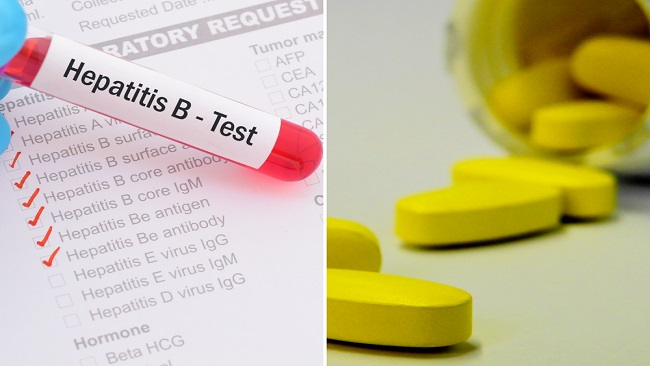Hepatitis B treatment suboptimal in people with HIV in Cameroon
Testing for chronic hepatitis B infection was very low in people living with HIV in Cameroon, a country with a high burden of hepatitis B, and suppression of hepatitis B virus was suboptimal in people with HIV on antiretroviral therapy, Cameroonian and French researchers report in BMC Infectious Diseases.
Hepatitis B is a common co-infection in people living with HIV. The World Health Organization estimates that approximately 7% of people living with HIV have co-infection with hepatitis B and three-quarters of them live in sub-Saharan Africa. The prevalence of hepatitis B co-infection in people living with HIV is especially high in west and central Africa (around 12%).
World Health Organization guidelines recommend that people who test positive for hepatitis B antibodies should be tested for hepatitis B surface antigen to check for chronic infection and should receive antiretroviral treatment with a regimen that contains tenofovir disoproxil fumarate (TDF), which is also active against hepatitis B virus.
To investigate management of hepatitis B co-infection, Cameroonian and French researchers carried out a cross-sectional study at 19 HIV clinics in central Cameroon in 2014 (the EVOLCAM study). The study sites included clinics in the country’s two largest cities, Yaoundé and Douala.
The research team wanted to find out what proportion of patients at these clinics had been tested for hepatitis B surface antigen and how many were receiving appropriate treatment in accordance with national guidelines, and what proportion had suppressed hepatitis B virus.
The study recruited adults presenting at HIV clinics who had been on antiretroviral treatment for more than six months. Study participants underwent medical examination, blood tests and were interviewed regarding risk factors for hepatitis B infection and sociodemographic characteristics.
The study recruited 1718 participants who had been on antiretroviral treatment for a median of 3.4 years. Just under three-quarters (74%) were women and 75% had a viral load below 300 copies/ml (undetectable). Nine per cent (159 patients) were hepatitis B surface antigen positive and of these, 15% had been diagnosed hepatitis B surface antigen positive prior to the study.
Seventeen per cent of all participants had been tested for hepatitis B surface antigen prior to the study. Almost half of these participants had not been tested for hepatitis B surface antigen before starting antiretroviral therapy and in these people the median interval between starting treatment and being tested for hepatitis B surface antigen was 42 months.
Women were less likely to be tested than men (adjusted odds ratio 0.64, 95% CI 0.46-0.89, p = 0.010) and testing was more likely to have taken place in people who started treatment after 2010 (aOR 1.66, 95% CI 1.23-2.27, p < 0.001), in those with secondary or higher education (aOR 1.38, 95% CI 1.02-1.90, p = 0.042) and in those with a higher ALT level (aOR 1.26 per 10 IU/L, 95% CI 1.15-1.39, p < 0.001).
There were also big differences in testing between clinics. Whereas 72.5% of participants had already been tested at one clinic, fewer than 10% of participants had been tested at nine study sites and only two study sites had tested more than half of participants for hepatitis B surface antigen prior to the study. The investigators are unable to explain this finding.
Looking at treatment, the researchers found that 30 out of 34 people diagnosed with chronic hepatitis B prior to the study were receiving tenofovir-containing regimens. Overall, 61% of people recruited to the study received tenofovir and either emtricitabine or lamivudine (also active against hepatitis B), 35.2% a combination containing emtricitabine or lamivudine and 1.9% a combination containing tenofovir alone.
Despite the high frequency of treatment with drugs active against hepatitis B, hepatitis B viral load suppression was suboptimal; 72% had a viral load below 10 IU/ml and viral suppression was more likely in participants who also had a fully suppressed HIV viral load (aOR 3.46, 95% CI 1.48-8.09, p = 0.004) and in participants who were receiving HIV treatment at a secondary treatment centre, largely located in district hospitals (aOR 2.79, 95% CI 1.24-6.27, p = 0.013).
Patients with unsuppressed hepatitis B viral load had been on antiretroviral treatment for a median of four years but multivariate analysis did not identify any antiretroviral treatment factors, including drugs in the regimen or adherence, associated with viral suppression.
Participants with higher ALT levels were less likely to have suppressed hepatitis B viral load (aOR 0.86 per 10 IU/ml increase in ALT, 95% CI 0.75-0.97, p = 0.019). These patients were at particular risk of liver disease progression, the study investigators point out.
“The decision of some AIDS programmes (including Cameroon’s since 2016) not to test for hepatitis B virus because TDF + 3TC [lamivudine] (or FTC) [emtricitabine] is included in standard regimens should be reviewed,” the study investigators conclude.
Source: aidsmap.com





